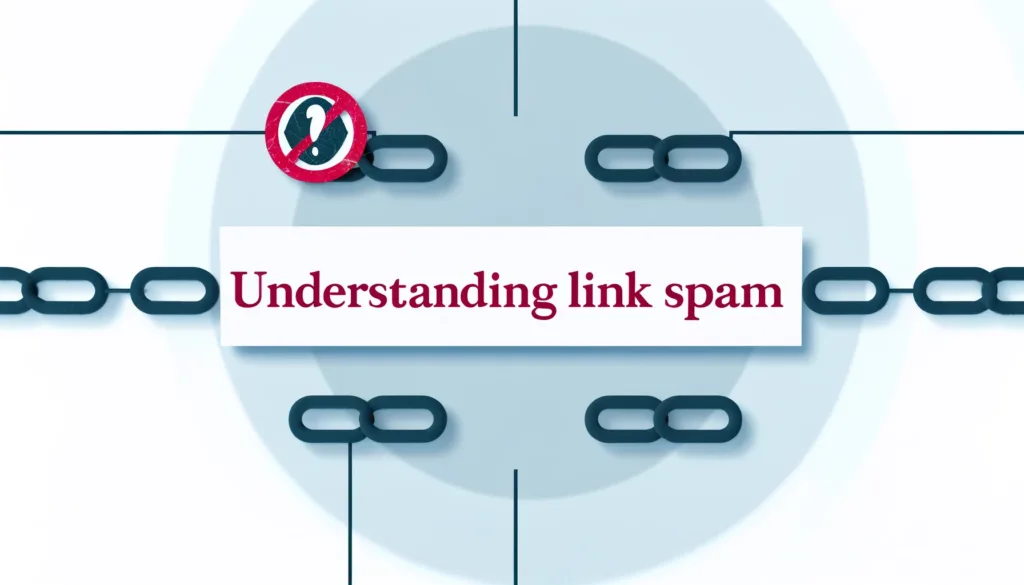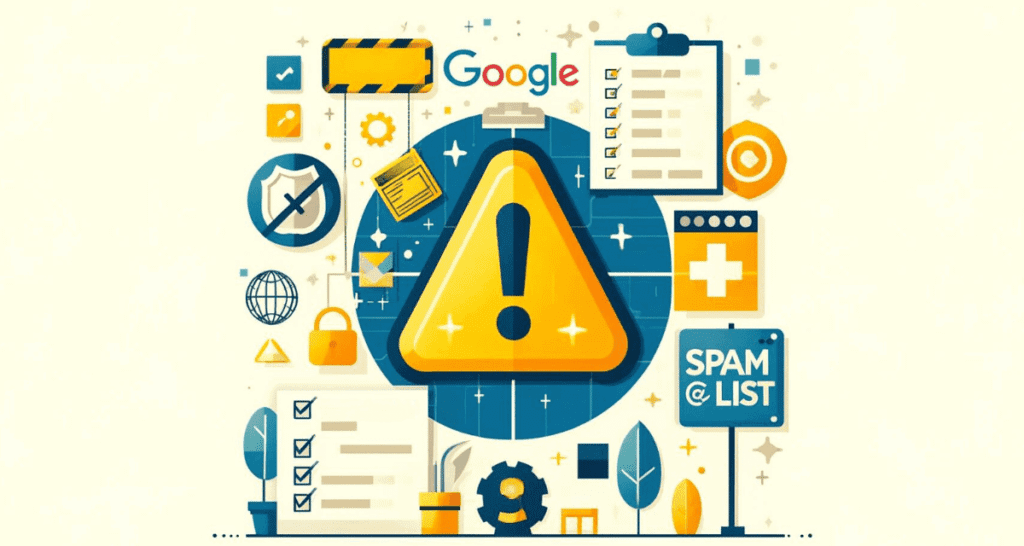One wrong step, and you might find your website flagged on Google’s spamming list. But fear not! With the right knowledge and tools, you can steer clear of these pitfalls and maintain a pristine digital presence.
Understanding Link Spam


Link spam, also known as spamdexing, is a tactic used to manipulate search engine results. It harms both the credibility and rankings of websites. Recognizing and avoiding link spam is important for maintaining a website’s SEO health.
What is Link Spam?
Link spam refers to the practice of creating or distributing unwanted or manipulative links. The primary goal is to artificially boost a website’s ranking in search engine results pages (SERPs). Unfortunately, this practice can lead to severe penalties from search engines like Google.
Common Types of Link Spam
Link Farms
Description: A network of websites that link to each other to increase their search engine rankings.
Avoidance Tip: Regularly audit your backlink profile using tools like Google’s Search Console to identify and disavow links from these networks.
Private Blog Networks (PBNs)
Description: Collections of blogs or websites created to generate links to a target site, often using expired domains with residual authority.
Avoidance Tip: Focus on earning links through high-quality content and legitimate SEO strategies instead of participating in PBNs.
Hidden Links
Description: Links invisible to visitors but visible to search engines, often used to deceive search engine algorithms.
Avoidance Tip: Ensure that all links on your website are visible and valuable to your visitors. Use CSS and HTML for styling purposes only, not for hiding links.
Comment Spam
Description: The practice of posting irrelevant links in the comment sections of websites, blogs, and forums.
Avoidance Tip: Implement anti-spam measures on your website, such as CAPTCHAs or comment moderation, to prevent automated spam.
Backlinks from Low-Quality Domains
Description: Links from websites that offer little to no value, often associated with spammy or prohibited content.
Avoidance Tip: Use tools like Moz’s Link Explorer to evaluate the quality of your incoming links and remove or disown those from low-quality domains.
Low-Quality Directory Spam
Description: Listings in low-quality directories that exist solely to manipulate SEO.
Avoidance Tip: Only list your website in reputable directories relevant to your industry.
How to Avoid Link Spam
Conduct Regular Audits: Use SEO tools to regularly inspect your link profile for any signs of spammy or low-quality links.
Educate Yourself and Your Team: Stay informed about the latest SEO practices and ensure your team understands the importance of ethical SEO.
Focus on Quality: Aim to create high-quality content that naturally attracts reputable backlinks.
By understanding and avoiding link spam, you can safeguard your website from penalties and maintain a healthy digital presence.
The Consequences of Google Penalties


Landing on Google’s spamming list is a scenario you’d want to avoid at all costs. The consequences can be dire, affecting not just your site’s traffic but its overall digital presence.
Understanding Google Penalties
What Triggers a Penalty?
Infringements: Penalties can result from violations such as link spam, keyword stuffing, or cloaking.
Updates: Google’s algorithm updates, like Panda and Penguin, often target specific SEO tactics deemed manipulative or low-quality.
Types of Penalties
Manual Actions: These are penalties directly applied by Google’s team for severe violations.
Algorithmic Penalties: These occur automatically, based on updates or changes in Google’s algorithms.
Impact on Traffic and Rankings
Immediate Drop in Traffic
Case Studies: Businesses have experienced drops of up to 80% in organic traffic overnight due to penalties.
Recovery Time: Depending on the severity, recovering from a penalty can take anywhere from weeks to years.
Loss of Visibility
Search Presence: A penalized site can disappear from top search results, losing visibility to potential customers.
Recovery Process
Identifying the Issue
Audit: Conduct a thorough review of your website and backlink profile to identify violations.
Google Search Console: Utilize Google’s tools to understand the nature of the penalty.
Steps to Recovery
Rectify Violations: Remove or disavow spammy links, revise content, and eliminate any black-hat SEO tactics.
Reconsideration Requests: Submit a detailed request to Google, explaining the actions taken to correct the issues.
Building Back Better
Quality Content: Focus on creating valuable, user-centric content that adheres to Google’s guidelines.
Ethical SEO Practices: Embrace SEO strategies that prioritize long-term growth over quick wins.
Preventive Measures
Continuous Education: Stay updated on Google’s guidelines and algorithm updates to avoid future penalties.
Regular Audits: Perform routine checks on your website’s content and backlink profile to ensure compliance with SEO best practices.
Google penalties can significantly impact your site’s performance and reputation. Understanding the triggers, types, and recovery strategies is crucial for maintaining a strong online presence and avoiding the pitfalls of non-compliance.
Key Google Spam Flags and Updates to Be Aware Of


Staying ahead in the SEO game requires familiarity with what Google considers spammy practices and the major algorithm updates that have reshaped the search landscape over the years.
Google’s Spam Flags
Google flags certain behaviors as indicators of spammy or manipulative practices. Recognizing these can help you avoid potential penalties:
Content Quality: Low-quality, thin, or duplicated content is a major red flag for Google.
Unnatural Links: An unnatural link profile, including purchased links or participation in link schemes, can trigger penalties.
Over-Optimization: Stuffing keywords and over-optimizing on-page elements can be counterproductive and flagged as spam.
User Experience: Google prioritizes the user experience. Sites that are difficult to navigate, slow to load, or filled with intrusive ads can be penalized.
Major Google Algorithm Updates
Mastering Google’s algorithm updates is vital for achieving SEO success. These updates target specific aspects of websites and search results, aiming to improve the quality and relevance of search outcomes for users.
Panda Update
Focus: Content quality.
Goal: Penalize low-quality, thin, or duplicate content and reward unique, valuable content.
Penguin Update
Focus: Link quality.
Goal: Penalize sites engaging in manipulative link practices and reward sites with natural, relevant link profiles.
Hummingbird Update
Focus: Keyword relevance and context.
Goal: Improve Google’s ability to understand search queries and match them with more relevant search results.
Mobile-Friendly Update
Focus: Mobile usability.
Goal: Boost the ranking of mobile-friendly pages on mobile search results and ensure users have a positive browsing experience on mobile devices.
Navigating Algorithm Updates
Stay Informed: Keep up to date with Google’s announcements and SEO news sources to anticipate and understand the impact of algorithm updates.
Audit Regularly: Conduct regular audits of your website to ensure compliance with Google’s quality guidelines, especially concerning content and link practices.
Embrace Quality: Prioritize creating high-quality content, building natural backlinks, and optimizing user experience across all devices.
By familiarizing yourself with Google’s spam flags and understanding the implications of major algorithm updates, you can develop strategies that align with Google’s focus on quality and user experience, ensuring your site remains in good standing.
Here’s a guide to Getting Familiar With Google’s Latest Update on AI-Generated Content.
Avoiding Copyright Infringement and Link Schemes
In the digital world, the integrity of your content and the legitimacy of your SEO practices are paramount. Steering clear of copyright infringement and link schemes not only keeps you on the right side of Google’s guidelines but also enhances your website’s credibility and trustworthiness.
Copyright Infringement: A Serious Offense
Understanding the Risks
Copyright infringement involves using copyrighted material without permission or adequate attribution. This may encompass text, images, videos, and other media formats.
DMCA Takedowns: Google responds to Digital Millennium Copyright Act (DMCA) takedown requests, which can result in the removal of infringing content from search results or even the delisting of entire websites.
Best Practices for Avoidance
Original Content: Always prioritize creating or sourcing original content. When using third-party content, ensure you have the right to use it and provide appropriate attribution.
Use Licensed Resources: Utilize stock image websites and content platforms that offer licensed material for commercial use. This reduces the likelihood of unintentional infringement.
The Perils of Link Schemes
What Constitutes a Link Scheme?
Link schemes are attempts to manipulate page ranking or a site’s ranking in Google search results. This can include buying or selling links, excessive link exchanges, or large-scale article marketing or guest posting campaigns with keyword-rich anchor text links.
Steering Clear of Link Schemes
Natural Link Building: Focus on earning links through high-quality content, user engagement, and genuine relationships within your industry.
Transparency and Honesty: Be transparent about the nature of your links. Use “nofollow” or “sponsored” attributes for links that might be considered part of advertising or sponsorships.
Implementing a Safe SEO Strategy
Educate Your Team: Ensure that everyone involved in your content creation and SEO strategy understands the importance of adhering to copyright laws and Google’s guidelines on link building.
Regular Audits: Conduct periodic audits of your content and backlinks to identify and rectify any potential issues before they escalate.
Creating a Robust SEO Strategy
A strong SEO strategy is the backbone of any successful online presence. It involves careful planning, execution, and continuous optimization to meet the ever-evolving standards of search engines and the needs of your audience.
Understanding SEO Fundamentals
The Core Elements of SEO
On-Page SEO: Involves optimizing individual web pages to achieve higher rankings and attract more relevant traffic. This includes content quality, keyword optimization, and user experience.
Off-Page SEO: Actions taken outside of your own website to impact your rankings within search engine results pages (SERPs), primarily through backlinks.
Technical SEO: Ensures that a website meets the technical requirements of modern search engines with the goal of improved organic rankings. Critical aspects include site speed, mobile-friendliness, and structured data.
Developing Your SEO Plan
Setting Goals
Define what success looks like for your website, whether it’s increasing organic traffic, improving keyword rankings, or boosting conversions.
Conducting Keyword Research
Use tools like Google Keyword Planner or SEMrush to identify the keywords and phrases most relevant to your content and audience.
Auditing Your Website
Perform a comprehensive SEO audit to identify strengths, weaknesses, and opportunities for improvement. This should cover content, site architecture, and link profile.
Implementing Your Strategy
Content Creation and Optimization
Develop a content strategy that addresses your audience’s needs, incorporates target keywords naturally, and aligns with your SEO goals.
Building Quality Backlinks
Concentrate on acquiring backlinks from reputable websites within your industry.
Guest blogging, industry forums, and digital PR can help build your backlink profile.
Monitoring and Adjusting
Use analytics tools to track your progress and make data-driven adjustments to your strategy. Google Analytics and Google Search Console are indispensable tools for monitoring organic search performance.
Best Practices for a Successful SEO Strategy
Stay Updated: SEO is an ever-changing field. Stay informed about the latest trends and algorithm updates to adapt your strategy as needed.
User Experience First: A positive user experience is crucial. Ensure your site is easy to navigate, loads quickly, and is mobile-friendly.
Quality Over Quantity: When it comes to content and backlinks, prioritize quality. High-quality content and backlinks from authoritative sites will have a more significant impact on your SEO than large quantities of low-quality content or links.
Resources for Further Learning
Common SEO Mistakes to Avoid
Avoiding common SEO mistakes is crucial for maintaining the health of your website and ensuring it ranks well in search engine results. Here are key errors to steer clear of and strategies to correct them.
1. Ignoring the Importance of Content Quality
The Mistake
Focusing solely on SEO tactics without prioritizing the quality and relevance of the content can lead to a decline in user engagement and search rankings.
The Fix
Invest in creating high-quality, informative content that addresses the needs and questions of your audience. Content should be engaging, original, and provide real value.
We have discussed in detail The Role of Content in User Engagement: A Comprehensive Guide.
2. Neglecting Mobile Usability
The Mistake
With over half of global web traffic coming from mobile devices, ignoring mobile usability can significantly harm your SEO and user experience.
The Fix
Ensure your website is responsive and mobile-friendly. This means fast loading times, easily clickable links, and content that adjusts smoothly to various screen sizes.
Some Resources to consider :
- Improving Mobile User Experience to Boost SEO.
- How to Conduct Mobile Keyword Research for SEO.
- The Ultimate Mobile SEO Checklist: Your Guide to Optimizing for Mobile Users.
3. Overlooking Title Tags and Meta Descriptions
The Mistake
Title tags and meta descriptions are crucial for SEO and user click-through rates from search engine results pages (SERPs). Neglecting them can result in missed opportunities to attract organic traffic.
The Fix
Craft compelling, keyword-rich title tags and meta descriptions for each page on your site. They should accurately describe the page content and entice users to click through.
4. Using Duplicate or Thin Content
The Mistake
Publishing duplicate or superficial content not only diminishes the user experience but also risks penalization from search engines.
The Fix
Focus on providing unique, detailed content that covers topics comprehensively. Use tools like Copyscape to ensure your content’s originality.
There is an article written by our experts on Utilizing ChatGPT for Secure Content Creation: Shielding Against Google’s Spam Filters.
5. Forgetting About Analytics
The Mistake
Not utilizing analytics tools to track your SEO performance is a missed opportunity for optimization and growth.
The Fix
Regularly track your website’s performance using tools such as Google Analytics.
Analyze metrics
such as organic traffic, bounce rate, and conversion rates to inform your SEO strategy adjustments.
6. Ignoring Local SEO
The Mistake
For businesses that operate locally, overlooking local SEO can result in missed engagement opportunities with the local audience.
The Fix
Optimize your online presence for local search by claiming your Google My Business listing, ensuring NAP (Name, Address, Phone Number) consistency across the web, and gathering positive reviews.
By avoiding these common SEO mistakes and implementing the suggested fixes, you can enhance your website’s search engine visibility, user engagement, and overall SEO performance.
Guide to Google My Business Optimization for 2024: Best Practices for Visibility and Growth.
Conclusion: Navigating SEO with Confidence
Successfully navigating SEO requires a comprehensive approach, combining an understanding of Google’s guidelines, a commitment to quality content, and a willingness to adapt to the changing digital environment. Here’s how you can confidently manage your SEO strategy:
Embrace Continuous Learning
SEO is not a set-it-and-forget-it task. It demands ongoing education and adaptation. Keep yourself updated on the newest trends, algorithm changes, and best practices. This proactive approach ensures your strategies remain effective and aligned with current standards.
Prioritize Quality and User Experience
At the heart of all your efforts should be a commitment to providing value to your users. High-quality, engaging content, a seamless user experience, and a mobile-friendly website are non-negotiable elements for success in today’s digital landscape.
Utilize Analytics and Tools
Leverage the power of analytics tools like Google Analytics and Google Search Console to gain insights into your website’s performance. These tools help identify opportunities for improvement and guide your SEO strategy towards better outcomes.
Engage in Ethical SEO Practices
Shortcuts and manipulative tactics might offer temporary gains, but sustainable success comes from ethical SEO practices. Focus on building your site’s reputation through legitimate means, such as natural link-building, creating original content, and optimizing for user intent.
Keep Your Audience at the Forefront
Understanding your audience’s needs and preferences is crucial. Tailor your content and SEO strategies to address these needs, ensuring your site remains relevant and valuable to those you aim to serve.
Stay Resilient and Adaptable
The path to SEO success is not always linear. Embrace challenges as opportunities for growth and be prepared to pivot your strategies in response to new information and changing landscapes.
By adhering to these principles, you can confidently navigate the complexities of SEO, ensuring your website not only avoids penalties but also achieves sustained visibility and engagement in the digital realm.
- Leveraging the Lastmod Tag in WordPress 6.5 for Superior SEO - May 23, 2024
- The Essential Role of Human Intervention in AI Content Creation - April 2, 2024
- Criteria for Google’s Spamming List: Avoiding the Pitfalls - April 1, 2024

